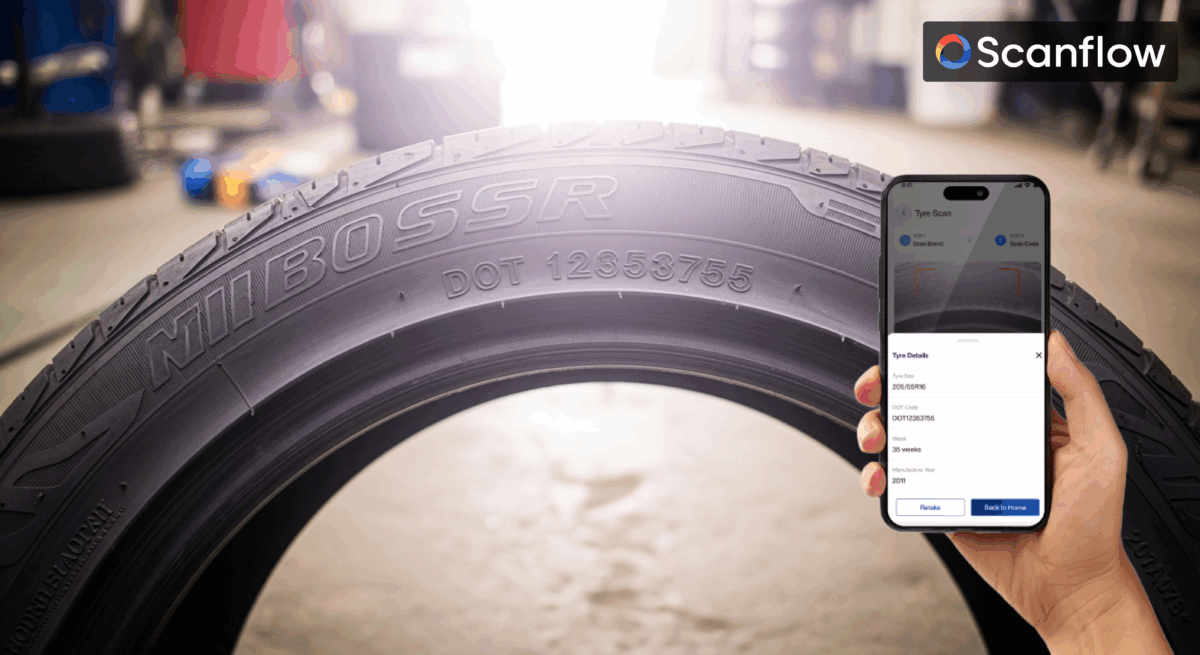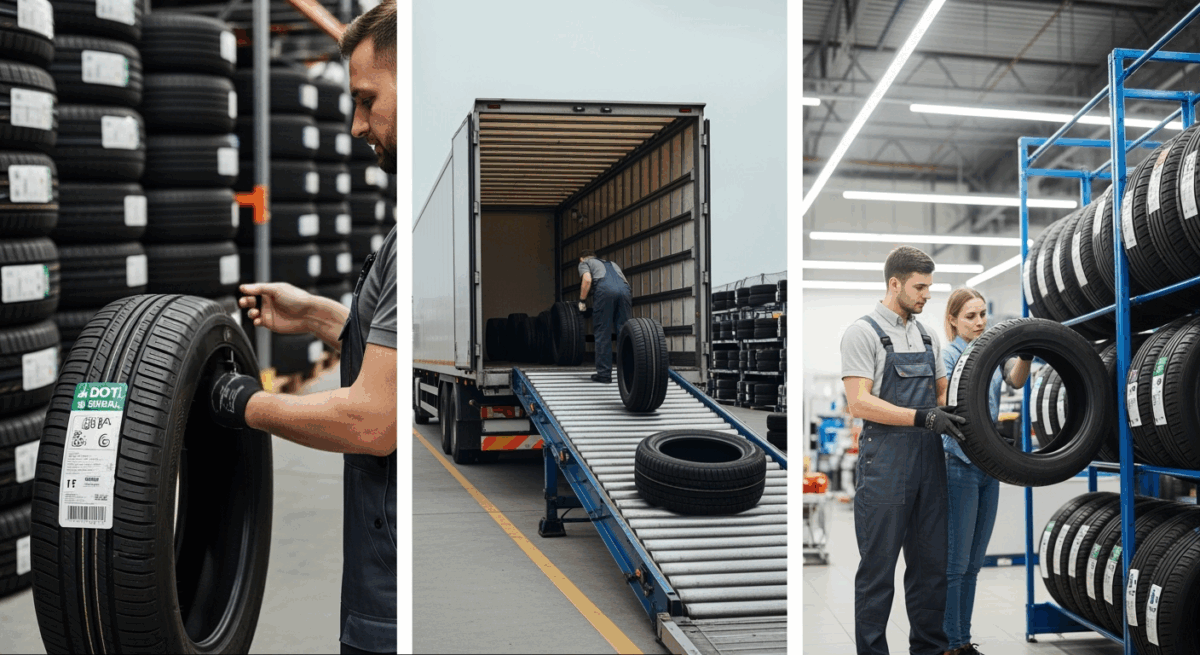How 3PL Providers Use Mobile Serial Number Scanning to Enhance Traceability
Understanding the Role of Serial Number Scanning in 3PL Operations In today’s hyperconnected lo...
4 Mins read
Posted on Oct 10, 2025
October 13, 2025
5 Mins read

Scanflow’s tire sidewall scanning system harnesses mobile edge offline SDK that supports for both Android, iOS, Web and API which accurately and efficiently extract critical information such as DOT, size, model number, and brand from real-time images using smartphones and tablets. This article presents a technically robust account of each pipeline stage, relevant algorithms, and […]
Scanflow’s tire sidewall scanning system harnesses mobile edge offline SDK that supports for both Android, iOS, Web and API which accurately and efficiently extract critical information such as DOT, size, model number, and brand from real-time images using smartphones and tablets. This article presents a technically robust account of each pipeline stage, relevant algorithms, and formulaic logic.
System Architecture: Edge-Driven Pipeline
Device & Data Capture Layer
Operators use a mobile app integrated with the Scanflow SDK. Images of the tire sidewall are captured using the built-in camera, under varying environmental conditions (light, dust, wear).
Real-time pre-processing ensures noise reduction and optimal imaging
Iproc = Enhance (Iraw), where Iraw is the input image and Iproc is the denoised, contrast-adjusted output.
Pre-processing workflow for tyre sidewall capture using the Scanflow Core SDK on mobile devices which has Scanflow Customized AI Camera. This step is critical, only high-quality frames make it to later stages, so scanning accuracy starts here.
The app uses Scanflow’s SDK (ScanFlowCameraSession, ScanTrustCameraManager)
Frame Filtering Algorithms:
Every frame is rapidly checked with a sequence of filters:
Sharpness Detection
Uses algorithms like Laplacian variance: computes edge sharpness. If variance is below a threshold, frame is too blurry and discarded.
S=Var(∇2I)
Where S is sharpnes, I frame image.
Motion Blur/Artifact Check
Simple frame-to-frame comparison assesses motion using optical flow or frame difference. If the tyre area shifts too much between frames, it’s rejected.
Exposure and White Balance:
Frames under- or over-exposed (too dark/bright) are detected with pixel intensity statistics:
Only frames passing ALL filters are sent to model inference (segmentation/OCR).
for (Frame frame : cameraBuffer) {
if (!isSharp(frame)) continue;
if (isMotionBlurred(frame)) continue;
if (!hasGoodContrast(frame)) continue;
if (!isProperlyExposed(frame)) continue;
if (!isCentered(frame)) continue;
processFrame(frame); // Pass to segmentation & OCR
}Image Segmentation & Region of Interest (ROI) Detection
The SDK’s CV engine applies edge detection and region heuristics (Canny, Hough, and deep learning models) to localize key regions:
ROI = (Iproc) ROI = Detect (Iproc)
Segmentation leverages Custome model architectures for instance localization.
Optical Character Recognition (OCR)
P(ci) = Softmax(zi)
DOT = RegexSearch( S, DOT pattern )
Size= RegexSearch( S, Size pattern )
Manufacturer/brand is classified via context signals and dictionary lookups.
Semantic Parsing & Data Structuring
Extracted entities are tagged and validated:
Week/year codes from DOT (e.g., 4-digit decode: YYWW)
Size pattern (Width/Aspect Ratio R Diameter), matched by regex or neural text extraction
Model number filtered by fuzzy match to database records
The feature vector:
Vtire = [DOT, Size, Model_No, Brand]
Local Edge Validation & Timestamping
All critical data is validated on-device using checksum algorithms and cross-checks with reference datasets:
Valid = fcheck( Vtire, DBtire )
Timestamp and geotag are appended for traceability.
Edge Custome Model: Tuning for Tire Sidewall Capture
Model Training & Optimization
Training images are annotated for texture, contrast anomalies, and typical defect cases. Trained with 1 Million data sets
Loss functions combine categorical cross-entropy (for OCR) and segmentation IOU
Ltotal=αLocr+βLiou
Dataset diversity (thousands of brands, types, conditions) ensures generalizability and noise resilience.
The Mobile models are quantized using for real-time, low-latency inference (<300ms typical).
The mobile will completely run on edge with Offline capability for field/yard use.
Data Usage in Model Training
The foundation of Scanflow’s tire sidewall scanning model lies in meticulously collected, annotated, and curated datasets, incorporating diverse real-world edge cases. The dataset is used for training various AI models that perform segmentation, text detection, and recognition in a multi-stage pipeline:
Multi-stage Training
L=Lcls+Lbox+Lmask
Data Privacy and Security For Enterprise System Integration
Comparison statistics report of Scanflow and other Commercial SDKs available in Market.
Here is a comparative chart that illustrates the stability, accuracy, and performance (speed) of the Scanflow SDK versus three other commercial tire sidewall scanning SDKs. The values are on a 0-100 scale based on typical reported benchmarks and user feedback:
This visual comparison helps users quickly comprehend how Scanflow excels in delivering reliable, accurate, and fast tire sidewall scanning.
Users can visualize Scanflow outperforming competitors on all three parameters, indicating reliability and speed combined with superior detection accuracy.
Such a chart helps technical users quickly assess and compare SDK capabilities for integration or evaluation purposes. If needed, this can be presented as a grouped bar chart with distinct colors per metric for clarity.
Let’s take a comparison metrics with leading Competitor A SDK.
| Metric / Condition | Scanflow | Competitor A | Scanflow Advantage |
|---|---|---|---|
| Overall Accuracy | 96.6% | 85.1% | ✅ +11.5% higher accuracy |
| Old & Glared Tyres | 100% | Not specified | ✅ Proven capability on aged/glared surfaces |
| Blurred Images | 86% | 54% | ✅ Handles blurred captures (partial recovery possible) |
| Accuracy in Challenging Conditions | Very High | Low | ✅ Robust in difficult lighting/angles |
| Consistency Across Conditions | Very High | Moderate | ✅ Reliable across varying scenarios |
Scanflow Leading Metrics (Compared to Competitor A)
| Criteria | Scanflow | Competitor A | Scanflow Advantage |
|---|---|---|---|
| Tyre Compatibility | Works on any tyres | Car tyres only | ✅ Universal tyre support |
| Blurry Image Handling | Excellent | Poor | ✅ Handles low-quality images effectively |
| Challenging Conditions | Handles well | Struggles | ✅ Robust under real-world conditions |
| Offline Support | ✅ Fully Offline | ❌ Requires Internet | ✅ Works without connectivity |
| DOT Code ROI Handling | More flexible | Very narrow ROI box | ✅ Adapts better to varying code areas |
| Partial Value Return | ✅ Returns partial values | ❌ Not supported | ✅ Can decode incomplete DOT codes |
| Text Angle Handling | Tolerates a range of angles | Best when perpendicular | ✅ Works across multiple orientations |
| Default Camera Mode | Uses wide-angle (may need tuning) | Neutral | ✅ Broader field |
Summary
Scanflow’s tire sidewall scanning SDK combines cutting-edge AI models, mobile-optimized processing, comprehensive and accurate data extraction, and seamless integration, backed by industry-leading stability and performance. These technical strengths ensure developers and businesses gain a robust, future proof solution, minimizing operational friction while maximizing insight and efficiency making Scanflow an unmatched choice in the tire scanning ecosystem.
Scanflow delivers enterprise-grade reliability, accuracy, and resilience, positioning itself as the most advanced and deployable tire sidewall scanning SDK in today’s market.
How 3PL Providers Use Mobile Serial Number Scanning to Enhance Traceability
4 Mins read
Posted on Oct 10, 2025
Why Traceability is Key for Tyre Movement Between Warehouses and Retailers
3 Mins read
Posted on Aug 21, 2025

This privacy policy sets out how Scanflow uses and protects any information that you give Scanflow when you use this website. Scanflow is committed to ensuring that your privacy is protected. We shall ask you to provide certain information by which you can be identified when using this website, then you can be assured that it will only be used in accordance with this privacy statement.
Scanflow may change this policy from time to time by updating this page. You should check this page from time to time to ensure that you are happy with any changes.
What We Collect
We may collect the following information:
Name and job title
Contact information including email address
Demographic information such as postcode, preferences and interests
Other information relevant to customer surveys and/or offers
What we do with the information we gather
We require this information to understand your needs and provide you with a better service, and in particular for the following reasons:
Internal record keeping.
We may use the information to improve our products and services.
We may periodically send promotional emails about new products, special offers or other information which we think you may find interesting using the email address which you have provided.
From time to time, we may also use your information to contact you for market research purposes. We may contact you by email, phone, fax or mail.
We may use the information to customize the website according to your interests.
Security
We are committed to ensuring that your information is secure. In order to prevent unauthorized access or disclosure, we have put in place suitable physical, electronic and managerial procedures to safeguard and secure the information we collect online.
How we use cookies
A cookie is a small file which asks permission to be placed on your computer’s hard drive. Once you agree, the file is added and the cookie helps analyze web traffic or lets you know when you visit a particular site. Cookies allow web applications to respond to you as an individual. The web application can tailor its operations to your needs, likes and dislikes by gathering and remembering information about your preferences.
We use traffic log cookies to identify which pages are being used. This helps us analyze data about webpage traffic and improve our website in order to tailor it to customer needs. We only use this information for statistical analysis purposes and then the data is removed from the system.
Overall, cookies help us provide you with a better website, by enabling us to monitor which pages you find useful and which you do not. A cookie in no way gives us access to your computer or any information about you, other than the data you choose to share with us.
You can choose to accept or decline cookies. Most web browsers automatically accept cookies, but you can usually modify your browser setting to decline cookies if you prefer. This may prevent you from taking full advantage of the website.
Links to other websites
Our website may contain links to other websites of interest. However, once you have used these links to leave our site, you should note that we do not have any control over that other website. Therefore, we cannot be responsible for the protection and privacy of any information which you provide whilst visiting such sites and such sites are not governed by this privacy statement. You should exercise caution and look at the privacy statement applicable to the website in question.
Controlling your personal information
You may choose to restrict the collection or use of your personal information in the following ways:
Whenever you are asked to fill in a form on the website, look for the box that you can click to indicate that you do not want the information to be used by anybody for direct marketing purposes
If you have previously agreed to us using your personal information for direct marketing purposes, you may change your mind at any time by writing to or emailing us at info@scanflow.ai We will not sell, distribute or lease your personal information to third parties unless we have your permission or are required by law to do so. We may use your personal information to send you promotional information about third parties which we think you may find interesting if you tell us that you wish this to happen. If you believe that any information, we are holding out from you is incorrect or incomplete, please write to or email us as soon as possible at the above address. We will promptly correct any information found to be incorrect.

